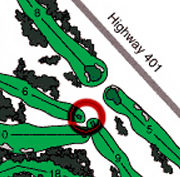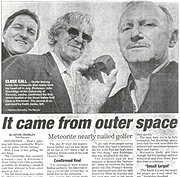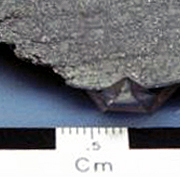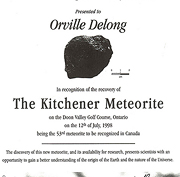Official Name:
Kitchener is the name of the city closest to where the meteorite fell.
Location:
On the Doon Valley golf course in the valley of the Grand River, Kitchener, Ontario.
Fall or Find:
This was an unusual fall. The passage of the meteorite was not seen, it was "felt."
Date:
12 July 1998, 8:30 a.m., local time.
Mass Recovered:
This nearly spherical meteorite weighs 202.6 grams and has a diameter of 4.5 centimetres. Kitchener is the size of a golf ball, but it is four times heavier.
Number of Fragments:
Only one fragment was recovered. Teams of scientists scoured the golf course for two days without success. The meteorite was probably a single fall.
Crater:
It would be hard to say that the Kitchener meteorite created an impact crater. It was recovered in a hole that was only 2.5 centimetres deep!
Circumstances:
Golfer Orville Delong was walking up to the sixth tee of the Doon Valley Golf Club in Kitchener when he heard a projectile pass near his left shoulder and felt a puff of wind. But it was not a lost golf ball-it was a small meteorite. The golfer immediately recovered the rock, which had fallen four metres in front of him with a dull thud. The rock was completely covered by a smooth black fusion crust. Mr. Delong noticed that the meteorite had a distinct odour.

Enlargement
Map of the Doon Valley Golf Club. The red circle shows the meteorite's point of impact. |
|

Enlargement
This newspaper article appeared a few days after the fall. Orville Delong is holding the meteorite he discovered. He is seen with Professor John Rucklidge (centre), who confirmed that the rock was a meteorite, and Keith Janke, of the Doon Valley Golf Club. |
|
History:
This meteorite fall was enthusiastically reported in the local newspapers. The publicity surrounding the fall encouraged one citizen to take a suspicious rock to be identified. That rock turned out to be an iron meteorite.
Orville Delong agreed to give the Kitchener meteorite to the Geological Survey of Canada in exchange for a plaster cast of his find, a thin section of the meteorite, and a season's pass to his favourite golf club!

Enlargement
Slice of the Kitchener meteorite. The thin fusion crust can be seen, as well as a few chondrules. |
|

Enlargement
Certificate given to Mr. Orville Delong to thank him for making his discovery available to scientists. |
|
Type:
Stony meteorite
Class:
Ordinary chondrite
Group:
L6
Composition:
The fusion crust varies in thickness, averaging 0.4 millimetre. The black surface of the meteorite contrasts sharply with its grey-white interior flecked with particles of iron. Apart from a few exceptions, the chondrules are rather difficult to make out. Thin black veins crisscross the meteorite.
Kitchener is an olivine-hypersthene chondrite. In addition to these two main constituents, the meteorite contains feldspar, troilite, kamacite, and taenite.
Scientific contribution:
Analysis of the meteorite showed the presence of isotopes produced by recent exposure to cosmic rays. The meteorite had been protected by the Earth's atmosphere for only a few days.
There is only one piece of this meteorite, and it is very small. So with great care, a fragment of Kitchener was cut for analysis, using a diamond wire saw. This limited loss of material. The meteorite was also kept dry during cutting, which limited contamination of the meteorite.
Comments:
Following this extraordinary event, managers of the Doon Valley Golf Club considered renaming it the Golf Club of the Stars.
Part of the Planétarium's collection:
No